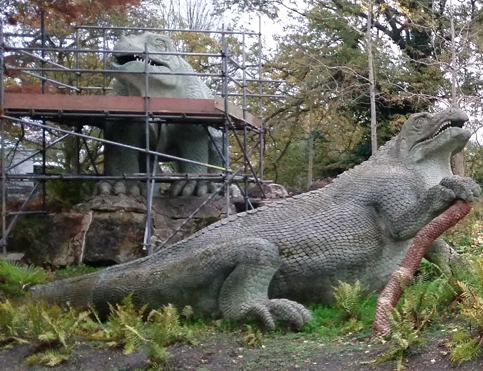Demoting a Dinosaur New Skull Material Takes Azendohsaurus out of the Dinosauria
Azendohsaurus – Not a Dinosaur, as Homer Simpson would say DOH!
A prehistoric reptile that roamed what was Africa in the middle of the Triassic that was once thought to be a primitive herbivorous dinosaur has been proven to be something altogether different. Analysis of new fossil material has identified this plant-eating reptile that shared the Triassic with the diversifying dinosaurs and pterosaurs, an animal named Azendohsaurus, as a member of the Archosauromorpha.
Azendohsaurus not a Dinosaur
A careful new analysis of Azendohsaurus madagaskarensis using more complete skull material aligns this Middle Triassic reptile with a very different and very early branch of the reptile evolutionary tree. Although it has several anatomical features that are similar to early herbivorous dinosaurs, new research by a team of scientists at the American Museum of Natural History (AMNH), indicates that this animal was wrongly assigned to the Dinosauria.
The holotype specimen of Azendohsaurus consists of fragmentary teeth and jaws that were discovered in 1972 close by (and named after) a small village in the Moroccan Atlas mountains. The perils of naming a genus of dinosaur based on teeth evidence alone is well documented, take for example the taxonomic difficulties which are still being encountered nearly 200 years after the naming and describing of the dinosaur genus known as Iguanodon.
The Crystal Palace Iguanodon Figures

A pair of Iguanodons study the Crystal Palace landscape. This dinosaur genus was first identified from fossil teeth. Picture credit: Everything Dinosaur.
Picture credit: Everything Dinosaur
However, the discovery of new, much more complete fossil material, including skull material and a number of individual specimens at a site in southwestern Madagascar has enabled scientists at the American Museum of Natural History (New York) to revise the classification of this particular Triassic reptile.
In a paper published in the scientific journal “Palaeontology”, the researchers state that many aspects of Azendohsaurus are far more primitive than previously assumed, which in turn means that its plant-eating adaptations, similar to those found with some early dinosaurs, were developed independently. This is evidence of covergent evolution, where different organisms evolve the same adaptations to cope with their environments and the ecosystem.
Commenting on the new research, John J. Flynn, curator in the Division of Palaeontology at the AMNH stated:
“Even though this extraordinary ancient reptile looks similar to some plant-eating Dinosaurs in some features of the skull and dentition, it is in fact only distantly related to Dinosaurs. With more complete material, we re-assessed features like the down-turned jaw and leaf-shaped teeth found in A. madagaskarensis as convergent with some herbivorous dinosaurs.”
Diagrams show a reconstruction of the skull of the new species of Azendohsaurus. On top is a lateral or side view, and on the bottom, a palatal or roof of the mouth view. Note the teeth covering the palate, a highly unusual feature among reptiles, and the down-turned front end of the lower jaw, a feature found independently in many herbivorous archosauromorphs.
This particular creature was initially described and published as an early dinosaur in the scientific journal “Science” over a decade ago, but the completeness of the more recently unearthed and studied fossils has provided the first complete glimpse of what this animal looked like and was related to. A. madagaskarensis was not a dinosaur.
A Member of the Archosauromorpha
A. madagaskarensis lived during the period of time that dinosaurs and other archosaurs such as crocodiles and pterosaurs were beginning to diversify. During this part of the Mesozoic one hemisphere (western) was dominated by a huge ocean (the Panthallassic Ocean) and the other hemisphere (eastern) was dominated by an enormous super-continent (Pangaea). It is possible to have fossils of the same animal found in Morocco and the island of Madagascar today, as during the Triassic, Madagascar and Morocco formed part of Pangaea. Madagascar did not break away from Africa until towards the end of the Mesozoic.
A. madagaskarensis was 2 to 4 metres long and weighed between 20 and 50 kilogrammes. A. madagaskarensis was an efficient herbivore with teeth modified for slicing vegetation covering not only its jaws but also the roof of its mouth.
John J. Flynn described this animal as:
“a veritable four-legged weed-whacker.”
Even though early archosaurs were commonly thought to be primarily carnivorous, A. madagaskarensis shows that traits associated with herbivory were much more widespread across archosaur reptiles.
Commenting on this new study, André Wyss, Professor at the University of California (Santa Barbara) stated:
“Now there are many more cases of herbivorous archosaurs. We are rethinking the evolution of diet and feeding strategies, as well as the broader evolution of the group.”
“This is the way science works,”
added Flynn, commenting on the reinterpretation of the fossils.
“As we found and analysed more material, it made us realise that this was a much more primitive animal and the dinosaur-like features were really the product of convergent evolution.”
André Wyss went onto state, that in many ways Azendohsaurus was turning out to be much more interesting as a non-dinosaur archosaur, than scientists could have imagined if it has stayed assigned to the Dinosauria as just another generic herbivore from the Middle Triassic.
Piecing together a prehistoric animal even when there is a copious amount of fossil material and data to work on is a very difficult task, with just the teeth and fragments of jaws to work with misinterpretations can occur. However, once more fossils have been discovered a more thorough analysis can take place. It is not uncommon for new material to lead to the revision of previously accepted work. So Azendohsaurus is not a member of the Dinosauria after all, as Homer Simpson would say Doh!
We are grateful for the American Museum of Natural History (AMNH) for information on this subject area.
Everything Dinosaur stocks an extensive range of models of archosaurs, including dinosaurs, pterosaurs and crocodilians: Archosaur Models and Prehistoric Animal Figures.

